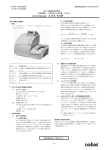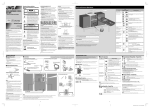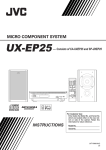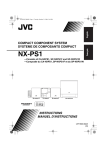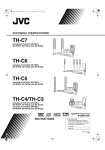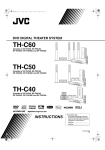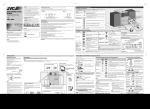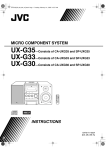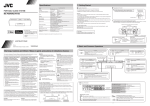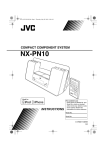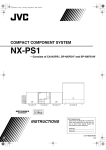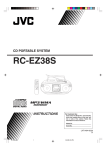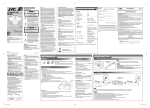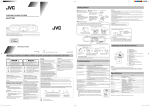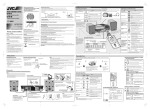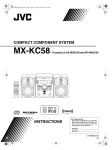Download JVC UX-EP100 User's Manual
Transcript
IMPORTANT FOR LASER PRODUCTS 1. CLASS 1 LASER PRODUCT 2. CAUTION: Do not open the top cover. There are no user serviceable parts inside the unit; leave all servicing to qualified service personnel. 3. CAUTION: (For U.S.A.) Visible and/or invisible class II laser radiation when open. Do not stare into beam. (For Canada) Visible and/or invisible class 1M laser radiation when open. Do not view directly with optical instruments. 4. REPRODUCTION OF LABEL: CAUTION LABEL, PLACED INSIDE THE UNIT. IMPORTANT POUR PRODUITS LASER 1. PRODUIT LASER CLASSE 1 2. ATTENTION: N’ouvrez pas le couvercle supérieur. Il n’y a aucune pièce réparable par l’utilisateur à l’intérieur de l’appareil; confiez toute réparation à un personnel qualifié. 3. ATTENTION: (Pour les Etats-Unis) Radiation laser de classe II visibles et/ou invisible si l’appareil est ouvert. Ne regardez pas le rayon. (Pour le Canada) Rayonnement laser visible et/ou invisible de classe 1M une fois ouvert. Ne pas regarder directement avec des instruments optiques. 4. REPRODUCTION DE L’ÉTIQUETTE: ÉTIQUETTE DE PRÉCAUTION PLACÉE À L’INTERIEUR DE L’APPAREIL. MICRO COMPONENT SYSTEM UX-EP100 Le symbole de l’éclair à l’intérieur d’un triangle équilatéral est destiné à alerter l’utilisateur sur la présence d’une “tension dangereuse” non isolée dans le boîtier du produit. Cette tension est suffisante pour provoquer l’électrocution de personnes. Le point d’exclamation à l’intérieur d’un triangle équilatéral est destiné à alerter l’utilisateur sur la présence d’opérations d’entretien importantes au sujet desquelles des renseignements se trouvent dans le manuel d’instructions. —Consists of CA-UXEP100 and SP-UXEP100 Thank you for purchasing a JVC product. INSTRUCTIONS GNT0076-001A[J/C] 0107ZZCMDWJEM ©2007 Victor Company of Japan, Limited For customer use Enter below the Model No. and Serial No. which are located either on the rear, bottom or side of the cabinet. Retain this information for future reference. Model No. Serial No. Warnings, Cautions and Others Mises en garde, précautions et indications diverses The lightning flash with arrowhead symbol, within an equilateral triangle is intended to alert the user to the presence of uninsulated “dangerous voltage” within the products enclosure that may be of sufficient magnitude to constitute a risk of electric shock to persons. The exclamation point within an equilateral triangle is intended to alert the user to the presence of important operating and maintenance (servicing) instructions in the literature accompanying the appliance. Note to CATV system installer: This reminder is provided to call the CATV system installer’s attention to Section 820-40 of the NEC which provides guidelines for proper grounding and, in particular, specifies that the cable ground shall be connected to the grounding system of the building, as close to the point of cable entry as practical. For U.S.A. This equipment has been tested and found to comply with the limits for a Class B digital device, pursuant to part 15 of the FCC Rules. These limits are designed to provide reasonable protection against harmful interference in a residential installation. This equipment generates, uses and can radiate radio frequency energy and, if not installed and used in accordance with the instructions, may cause harmful interference to radio communications. However, there is no guarantee that interference will not occur in a particular installation. If this equipment does cause harmful interference to radio or television reception, which can be determined by turning the equipment off and on, the user is encouraged to try to correct the interference by one or more of the following measures: Reorient or relocate the receiving antenna. Increase the separation between the equipment and receiver. Connect the equipment into an outlet on a circuit different from that to which the receiver is connected. Consult the dealer or an experienced radio/TV technician for help. CAUTION Changes or modifications not approved by JVC could void the user’s authority to operate the equipment. CAUTION: Excessive sound pressure from earphones or headphones can cause hearing loss. ATTENTION: Une pression acoustique excessive des écouteurs ou du casque d’écoute peut entraîner une perte auditive. Caution — button! Disconnect the mains plug to shut the power off completely (the STANDBY lamp goes off ). When installing the apparatus, ensure that the plug is easily accessible. The button in any position does not disconnect the mains line. • When the system is on standby, the STANDBY lamp lights red. • When the system is turned on, the STANDBY lamp goes off. The power can be remote controlled. ATTENTION—Touche ! Déconnectez la fiche secteur pour mettre l’appareil complètement hors tension (le témoin STANDBY l s’éteint). Lors de l’installation de l’appareil, assurez-vous que la fiche soit facilement accessible. La touche dans n’importe quelle position ne déconnecte pas l’appareil du secteur. • Quand l’appareil est en mode d’attente, le témoin STANDBY est allumé en rouge. • Quand l’appareil est sous tension, le témoin STANDBY s’éteint. L’alimentation peut être commandée à distance. CAUTION To reduce the risk of electrical shocks, fire, etc.: 1. Do not remove screws, covers or cabinet. 2. Do not expose this appliance to rain or moisture. ATTENTION Afin d’éviter tout risque d’électrocution, d’incendie, etc.: 1. Ne pas enlever les vis ni les panneaux et ne pas ouvrir le coffret de l’appareil. 2. Ne pas exposer l’appareil à la pluie ni à l’humidité. For Canada/pour le Canada THIS DIGITAL APPARATUS DOES NOT EXCEED THE CLASS B LIMITS FOR RADIO NOISE EMISSIONS FROM DIGITAL APPARATUS AS SET OUT IN THE INTERFERENCE-CAUSING EQUIPMENT STANDARD ENTITLED “DIGITAL APPARATUS,” ICES-003 OF THE DEPARTMENT OF COMMUNICATIONS. CET APPAREIL NUMERIQUE RESPECTE LES LIMITES DE BRUITS RADIOELECTRIQUES APPLICABLES AUX APPAREILS NUMIRIQUES DE CLASSE B PRESCRITES DANS LA NORME SUR LE MATERIEL BROUILLEUR; “APPAREILS NUMERIQUES”, NMB-003 EDICTEE PAR LE MINISTRE DES COMMUNICATIONS. Operating on the System To Turn on or off (standby) the power The STANDBY lamp on the System turns off/on. PHONES jack 1, 2 Select a source* STANDBY lamp See “Listening to iPod” on page 6. Press repeatedly to select “FM,” “AM,” or “LINE.” • For “FM” and “AM,” see “Listening to FM and AM Broadcasts” on page 5. • For “LINE,” see “Listening to Digital Audio Player” on page 6. You can adjust the volume level from level 0 (“VOL MIN”) to level 31 (“VOL MAX”). Adjust the volume Operating on the Remote Control To Turn on or off (standby) the power Press The STANDBY lamp on the System turns off/on. Point at the remote sensor on the front panel. (The operating range is approx. 7 m (23 ft).) See “Listening to iPod” on page 6. To See “Playing Back a Disc/USB Mass Storage Class Device” on page 4. [European Union only] [Union européenne seulement] There are no user-serviceable parts inside. If anything goes wrong, unplug the power cord and consult your dealer. Stereo mini plug cord See “Playing Back a Disc/USB Mass Storage Class Device” on page 4. Select a source*2 • If water gets inside the System, turn off the power and remove the plug from the wall outlet, then consult your dealer. Using the System in this state may cause a fire or electrical shock. • Do not expose the System to direct sunlight or place it near a heating device. Notes on installation • Select a place which is level, dry and neither too hot nor too cold between 5˚C (41˚F) and 35˚C (95˚F). • Do not install the System in a place subject to vibrations. • Do not put heavy objects on the System. To prevent malfunction or damage of the System • Do not insert any metallic objects, such as wires, hairpins, coins, etc. into the System. • Do not block the vents. Using Headphones Be sure to turn down the volume before connecting or putting on the headphones. • Connecting the headphones will deactivate the speakers. • Sound adjustments also affect the sound through the headphones. • Do not put the headphone cord on “touch sensor panel.” Press WARNING: TO REDUCE THE RISK OF FIRE OR ELECTRIC SHOCK, DO NOT EXPOSE THIS APPLIANCE TO RAIN OR MOISTURE. Precautions Notes on the power cord • When you are away on travel or otherwise for an extended period of time, remove the plug from the wall outlet. A small amount of power (2.5 W) is always consumed while the power cord is connected to the wall outlet. • When unplugging the System from the wall outlet, always pull the plug, not the power cord. • Do not handle the power cord with wet hands. • Disconnect the power cord before cleaning the System or moving the System. • Do not alter, twist or pull the power cord, or put anything heavy on it, which may cause fire, electric shock, or other accidents. • If the cord is damaged, consult a dealer and have the power cord replaced with a new one. Avoid moisture, water, dust, and high temperatures • Do not place the System in moist or dusty places. Basic and Common Operations Press repeatedly to select “FM,” “AM,” or “LINE.” • For “FM/AM,” see “Listening to FM and AM Broadcasts” on page 5. • For “LINE,” see “Listening to Digital Audio Player” on page 6. Adjust the volume You can adjust the volume level from level 0 (“VOL MIN”) to level 31 (“VOL MAX”). Drop the volume in a moment Reinforce the bass sound (Active Hyper Bass Pro function) To restore the volume, press again, or adjust the volume level. Press and hold until the AHB indicator lights on the display. To cancel this function, press and hold again. Adjust the tone (Bass/ Treble) • Once: for the bass level • Twice: for the treble level Then, press VOLUME + to increase the level or press VOLUME – to decrease it. • You can adjust the bass and/or treble level from –3 to +3. Press Press and hold for more than 2 seconds when the System is on standby. • Setting the Save mode allows you to reduce power consumption by turning the display off while on standby. To cancel this function, press and hold for more than 2 seconds again. Press briefly. For setting the clock, see “Setting the Clock and Daily Timer” on page 5. Press repeatedly to specify the time (in minutes) as follows (SLEEP indicator lights on the display): Set the Save mode Changing the display information (Clock and Source) Turn off the System by using the sleep timer Canceled • To check the remaining time to turn off after setting the sleep timer, press once. NOTICE • Do not put objects such as the headphone cord on “touch sensor panel.” • Do not put a fluorescent light near the System; otherwise, “touch sensor panel” may not work correctly. Display Information Source indicators (See the left table.) AHB indicator (See the left table.) RESUME indicator (See page 4.) FM reception File type indicators (See page 4.) indicators Source indicators (See the left table.) (See page 5.) *1 You can operate the source selecting buttons on the System by simply touching, because these buttons are “touch sensor panel.” *2 The corresponding source indicator lights on the display (not applicable for “LINE”). NOTE DO NOT turn off (standby) the System with the volume set to an extremely high level; otherwise, the sudden blast of sound can damage your hearing, speakers and/or headphones when you turn on the System or start playback. QPL indicator (See page 6.) Main Display A.STBY (Auto Standby) indicator (See page 4.) SLEEP indicator (See the left table.) Timer mode indicators (See page 5.) Play mode indicators (See page 4.) Press when the System is turned on. To cancel this function, press again. Changing the display brightness iPod is a trademark of Apple Inc., registered in the U.S. and other countries. 1 3 Getting Started Playing Back a Disc/USB Mass Storage Class Device Supplied Accessories Prepare the Remote Control After unpacking, check to be sure that you have all the following items. The number in parentheses indicates the quantity of each piece supplied. • Remote control (x 1) • Lithium coin battery CR2025 (x 1) (The battery has been installed when shipped from the factory.) • AM loop antenna (x 1) • FM antenna (x 1) • Connection cable for iPod (x 1) • Stand for iPod (x 1) If anything is missing, consult your dealer immediately. When you use the remote control for the first time, pull out the insulation sheet. Insulation sheet To Replace the Battery in the Remote Control Lithium coin battery (product number: CR2025) Insert the battery into the remote control by matching the polarity (+ and –) correctly. NOTES • Store the battery in a place where children cannot reach. If a child accidentally swallows the battery, consult a doctor immediately. • Do not recharge, short, disassemble or heat the battery or dispose of it in a fire. Doing any of these things may cause the battery to give off heat, crack, or start a fire. • Do not leave the battery with other metallic materials. Doing this may cause the battery to give off heat, crack, or start a fire. • When throwing away or saving the battery, wrap it in tape and insulate; otherwise, the battery may start to give off heat, crack, or start a fire. • Do not poke the battery with tweezers or similar tools. Doing this may cause the battery to give off heat, crack, or start a fire. • Dispose of battery in the proper manner, according to federal, state, and local regulations. • The batteries (battery pack or batteries installed ) shall not be exposed to excessive heat source such as sunshine, fire or the like. For USA-California Only This product contains a CR Coin Cell Lithium Battery which contains Perchlorate Material – special handling may apply. See www.dtsc.ca.gov/hazardouswaste/perchlorate CAUTION: Danger of explosion if battery is incorrectly replaced. Replace only with the same or equivalent type. Connections To assemble the AM loop antenna Do not connect the AC power cord until all other connections have been made. NOTES • Make sure the antenna conductors do not touch any other terminals, connecting cords and power cord. Also, keep the antennas away from metallic parts of the System, connecting cords, and the AC power cord. This could cause poor reception. • If the cords are covered with vinyl, remove the vinyl to expose the tip of the cord by twisting the vinyl. AM loop antenna (supplied) Turn it until the best reception is obtained. FM antenna (supplied) Extend it so that you can obtain the best reception. This System can play back... – CD. – CD-R/CD-RW recorded in audio CD format (CD-DA) or recorded MP3/ WMA files in ISO 9660 format. – USB mass storage class device which contains MP3/WMA files. • When playing back an MP3 or WMA track, MP3 or WMA indicator lights on the display. Loading a Disc 1 On the System only Press to open the disc tray. • When using an 8 cm (3-3/16 inches) disc, place it on the inner circle of the disc tray. 2 3 On the System Play back the USB mass storage class device Stop playback Press and hold until the A.STBY indicator lights on the display. • The A.STBY indicator starts flashing after playback stops. If no operation is done for about 3 minutes, the System turns off. To connect the speaker cords Make sure the both speakers are connected correctly and firmly. • Before connecting the speaker cords, twist and pull the insulation coat off and remove. When connecting the speaker cords, match the polarity of the speaker terminals: black cord with white stripe to (+) and black cord to (–). 2 NOTES • DO NOT connect more than one speaker to each terminal. • DO NOT allow the conductor of the speaker cords to be in touch with the metallic parts of the System. Select a track number to program. Press to program the selected track. Repeat steps 2 and 3 to program other tracks you want. • If you try to program a 33rd track, “FULL” will appear on the main display. The tracks are played back in the programmed order. or To Operate on the Program Play Mode Select a group (MP3/WMA only) — — — — Press to select the previous groups while playback is stopped. Press once or twice to fast-forward the track during playback. To stop searching, press 6. Press once or twice to fast-reverse the track during playback. To stop searching, press 6. RESUME Play When you stop the playback by one of the following operations, this System stores the beginning of the stopped track on the disc or stores the stopped position of the file on the USB mass storage class device. – Pressing 7 once (The RESUME indicator lights on the display.) – Changing the source – Turning off the System When you start playback again, playback starts from the stored position. To clear the stored position, press 7 while playback is stopped. • Opening the disc tray or disconnecting the USB mass storage class device also clears the stored position. NOTE This function does not work in program play and random play (see the right tables). Playing Repeatedly—Repeat Play Press repeatedly before you start playback to specify the repeat mode as follows: REP 1 Repeats the current (or specified) track. Repeats all tracks in the current group (MP3/ REP GRP WMA only). ALL REP ALL Repeats all tracks. REP OFF Normal playback 1 On the System only Press and hold 2 To Press to select the next groups while playback is stopped. NOTES • If no disc is inserted, “NO DISC” appears on the main display. • If no USB mass storage class device is connected, “NO USB” appears on the main display. • If MP3/WMA files are not recorded in the USB mass storage class device, “NO FILE” appears on the main display. You can lock the disc tray so that no one can eject the loaded disc. • This is possible while the System is on standby and the disc tray is closed. To cancel the prohibition, repeat the same procedure. 3 4 or Press to go back to the beginning of the current or previous tracks. To cancel this function, press and hold again. Prohibiting Disc Ejection 2 5 Forward search/ Reverse search Turning off the System Automatically —AUTO STANDBY function Press repeatedly until the PRGM (program) indicator lights on the display before playback. 1 Press to select the next tracks. You can connect a USB mass storage class device such as a USB flash memory device, MP3 player, multimedia card reader, etc. to the System. NOTES • When connecting with a USB cable, use the cable whose length is less than 1 m (3.3 ft). • USB mass storage class device is charged through the USB MEMORY terminal when the System is turned on and the source is “USB.” • You cannot connect a computer to the USB MEMORY terminal of the System. • Do not disconnect the USB mass storage class device when the System is turned on. It may cause malfunction of both this System and the device. Outdoor FM antenna (not supplied) On the remote • Current track number and elapsed playing time appear on the main display. For MP3/WMA files: Before current track number and elapsed playing time appear, the tag information is scrolled if it is recorded. • During playback, press again to pause. • While playback is stopped, total track number and total playing time (for MP3/WMA files, group number and track number) appear on the main display. Play back the disc USB cable (not supplied) For better FM reception To a wall outlet Plug the AC power cord only after all connections are complete. To Press to close the disc tray. Connecting a USB Mass Storage Class Device Programming the Playing Order— Program Play (not Applicable for MP3/ WMA Discs) Press Select a track Front view To connect the AM loop antenna Disconnect the supplied FM antenna, and connect to an outdoor FM antenna using a 75 Ω wire with coaxial type connector. Basic Disc/USB Mass Storage Class Device Operations or 4 Press Check the programmed contents or Press while playback is stopped. Repeat steps 2 and 3 above while playback is stopped. Press while playback is stopped. • The track and program numbers of the new last track appear on the main display. Add tracks Erase the last track Erase the entire program Press while playback is stopped. Exit from program play Press twice while playback is stopped. • The stored program is erased. Playing at Random—Random Play 1 2 or Press repeatedly until the RND (random) indicator lights on the display before you start playback. Playback starts in random order. Random Play ends when all tracks are played back. To Operate on the Random Play Mode To Press Skip a track • 4 does not work. Exit from random play Press once while playback is stopped. Setting the Clock and Daily Timer Listening to FM and AM Broadcasts Basic Tuner Operations Setting the Clock Without setting the built-in clock, you cannot use Daily Timer and Sleep Timer. • “AM 12:00” flashes on the main display until you set the clock. Press to activate the clock setting mode. Press To On the System On the remote or or Select a frequency — Change the FM reception mode (When an FM stereo broadcast is hard to receive or noisy) 1 Press repeatedly to select “FM” or “AM.” • The selected frequency appear on the main display. Press and hold for more than 2 seconds. The System starts searching for stations and stops when a station of sufficient signal strength is tuned in. • If an FM program is broadcast in stereo, the ST (stereo) indicator lights on the display (only when the reception is good). • Press during searching to stop. • Press repeatedly to change the frequency step by step. Select FM or AM Tune in to a preset station Learning More about This System • If you have already adjusted the clock before, press the button repeatedly until the clock setting mode is selected. 2 • To exit from the clock setting, press CLOCK/TIMER as required. • To go back to the previous step, press CANCEL. Setting the Daily Timer Press to select a preset number for the station you store. • For presetting stations, see below. or Using Daily Timer, you can wake up with your favorite music. • You can store three Daily Timer settings; however, you can activate only one of Daily Timers. Press repeatedly to select one of the timer setting modes you want to set—DAILY 1 ON time, DAILY 2 ON time, or DAILY 3 ON time—as follows: 1 Press to improve reception. The MONO indicator lights on the display. Reception will improve though the stereo effect is lost. To restore the stereo effect, press again. — Adjust the hour, then the minute. or DAILY 1 Timer DAILY 2 Timer ON (Time) DAILY 3 Timer ON (Time) Canceled Presetting Stations 2 You can preset 30 FM and 15 AM stations manually. Tune in to a station you want to preset. • You can also store the monaural reception mode for FM preset stations if selected. Press to activate the preset number entry mode. • Finish the following steps while the indication on the display is flashing. 1 2 3 or 4 or Press to select a preset number for the station you store. 3 Press to store the station. ON (Time) Clock setting mode (See above.) 1 Adjust the hour then the minute for on-time. 2 Adjust the hour then the minute for off-time. 3 Select the playback source—“TUNER-FM,” “TUNER-AM,” “DISC,” “LINE,” “USB,” or “IPOD.”* 4 For “FM/AM”: Select a preset channel. For “LINE”: Make the connected device ready for playback. 5 Select the volume level. • You can select the volume level (“VOLUME 0” to “VOLUME 31” and “VOLUME – –”). If you select “VOLUME – –,” the volume is set to the last level when the System is turned off. Turn off the System (on standby). • When the on-time of the daily timer comes, the System sets the volume level gradually to the preset level after about 10 seconds. * When “IPOD” is selected as the playback source, charge the iPod battery through the iPod terminal (see page 6); otherwise, Daily Timer may not work. • To exit from the timer setting, press CLOCK/TIMER as required. • To correct a misentry during the process, press CANCEL. You can return to the previous step. NOTE When you unplug the AC power cord or if a power failure occurs, the preset stations will be erased in a few hours. To Turn Off the Daily Timer 1 2 Press repeatedly to select “DAILY 1,” “DAILY 2,” or “DAILY 3.” Basic and Common Operations (see page 3) • Pressing one of the source buttons also turns on the System and starts playing back. Playing Back a Disc/USB Mass Storage Class Device (see page 4) • This System cannot play “packet write” discs. • For MP3/WMA playback... – In this manual, “file” and “track” are interchangeably used for MP3/WMA operations. – This System can show the Tag data (Version 1). – MP3/WMA discs are required a longer readout time than regular CDs. (It depends on the complexity of the group/ file configuration.) – Some MP3/WMA files cannot be played back and will be skipped. This result from their recording processes and conditions. – When making MP3/WMA discs, use ISO 9660 Level 1 or Level 2 for the disc format. – This System can play back MP3/WMA files with the extension code <.mp3> or <.wma> (regardless of the letter case—upper/lower). – It is recommended that you make each MP3/WMA file at a sampling rate of 44.1 kHz and at bit rate of 128 kbps. This System cannot play back files made at bit rate of less than 64 kbps. – Playback order of MP3/WMA tracks may be different from the one you have intended while recording. If a folder does not include MP3/WMA tracks, they are ignored. • For the USB mass storage class device playback... – When connecting a USB mass storage class device, also refer to its manual. – Connect one USB mass storage class device to the System at a time. Do not use a USB hub. – This System is compatible with the USB Full-Speed (not compatible with the USB 1.1). – You can play back MP3/WMA files in a USB mass storage class device (maximum data transfer rate: 2 Mbps). – You cannot play back a file larger than 2 Gigabyte. – This System cannot recognize a USB mass storage class device whose rating is other than 5 V and does not exceed 500 mA. – This System may not play back some USB mass storage class devices and does not support DRM (Digital Rights Management). • An iPod does not play on the USB MEMORY terminal. • This System can recognize up to 511 tracks in a disc/USB mass storage class device. Also, the System can recognize up to 150 tracks per group and up to 99 groups in a disc/ USB mass storage class device (for MP3/WMA). – Playable files which do not belong to any groups are handled as Group 1. To turn on the Daily Timer again, select one of the timer settings by pressing CLOCK/TIMER, then press SET. Troubleshooting Listening to iPod 1 Specifications To Play Back Digital Audio Player Easily Amplifier section Quick Portable Link (QP Link) automatically switches the source to LINE as the Digital Audio Player connected to the LINE IN jack starts playback. OUTPUT POWER: 12 W per channel, min. RMS, driven into 6 Ω at 1 kHz with no more than 10% total harmonic distortion Speakers/Impedance: 6 Ω – 16 Ω Audio input LINE IN: 500 mV/47 kΩ (at “LINE IN LVL1”) 250 mV/47 kΩ (at “LINE IN LVL2”) 125 mV/47 kΩ (at “LINE IN LVL3”) Audio output LINE OUT: 1.0 Vrms (47 kΩ) (at “LINE OUT LVL1”) 2.0 Vrms (47 kΩ) (at “LINE OUT LVL2”) Digital input: USB MEMORY Press and hold for more than 2 seconds to activate QP Link. The QPL indicator lights on the display. To cancel this function, press and hold for more than 2 seconds again. Front view Connection cable for iPod (supplied) Stand for iPod (supplied) When QP Link is activated, connecting a Digital Audio Player to the LINE IN jack and starting playback performs the following: – While listening to another source... Changes the source to “LINE” automatically. – While the System is on standby... Turns on the System and changes the source to “LINE” automatically (not applicable when the display is turned off ). NOTE See “Learning More about This System” on page 7. Turn the volume to minimum. 2 3 IMPORTANT: It should be noted that it may be unlawful to rerecord pre-recorded tapes, records, or discs without the consent of the owner of copyright in the sound or video recording, broadcast or cable program and in any literary, dramatic, musical, or artistic work embodied therein. Turn the arrow-mark side down when connecting the plug. The iPod is turned on and the last track you have selected is played back. • If the track is not played back automatically, press again. Adjust the volume level to the level you want to listen to. NOTES • When “iPod” is selected as the source... – “CONNECT” appears on the main display with the iPod connected. – “NO CONNE” appears on the main display without the iPod connected. • The iPod battery is charged through the iPod terminal in the following cases: – When the System is turned on and the source is “iPod.” – When the System is turned off. Recording on Digital Audio Player Digital Audio Player equipped with the audio input Listening to Digital Audio Player Digital Audio Player Basic iPod Operations To audio input Press To On the System Play back On the remote To audio output (or headphone out, etc.) Front view • During playback, press again to pause. Select a track/ Forward search/ Reverse search 1 • Press to select the next track. • Press and hold to fast-forward the track during playback. 2 • Press to go back to the beginning of the current or previous track. • Press and hold to fast-reverse the track during playback. To Turn off the iPod Press and hold for more than 2 seconds. • Turning off the System* or changing “iPod” to another source also turns off the iPod. * Turning off the System may not turn off the iPod depending on the current source. Disconnecting the iPod • When disconnecting the iPod, make sure this System is turned off. • To disconnect the cable from the iPod, press the buttons on the sides, while pulling it out. 3 4 NOTE If an iPod which is not on the compatible iPod types list above is connected, the iPod may not be operated from the System. In this case, deactivate the iPod battery charge function so that the iPod may be operated, but the iPod cannot be charged through the System. To deactivate the battery charge function, change the source to “iPod” and press and hold while no iPod is connected. • “P.OFF” appears on the main display. Stereo mini plug cord (not supplied) Turn the volume to minimum. Press repeatedly to select “LINE.” Start playing the Digital Audio Player connected. Adjust the volume level to the level you want to listen to. To Adjust the Audio Input Level If the sound from the Digital Audio Player connected to the LINE IN jack is too loud or too quiet, you can change the audio input level through the LINE IN jack (without changing the volume level). Press and hold for more than 2 seconds while “LINE” is selected as the source. You can select one of three levels as follows: To use the battery charge function, change the source to “iPod” and press and hold SET until “P.ON” appears on the main display. Power does not come on. \ Power plug is not inserted securely. Plug in securely. Adjustments or settings are suddenly canceled before you finish. \ There is a time limit. Repeat the procedure again. Operations are disabled. \ The built-in microprocessor may malfunction due to external electrical interference. Unplug the AC power cord and then plug it back in. Unable to operate the System from the remote control. \ The path between the remote control and the remote sensor on the System is blocked. \ The batteries are exhausted. No sound is heard. \ Speaker connections are incorrect or loose. \ Headphones are connected. The System does not work properly. \ Many functions of this System are implemented by microcomputers. If pressing any button does not result in the normal action, disconnect the AC power cord from the wall outlet, wait for a while, and connect the cord again. Disc/USB Mass Storage Class Device Operations The disc/USB mass storage class device does not play. \ The disc is placed upside down. Place the disc with the label side up. \ The disc is recorded with the “packet writing (UDF file system).” It cannot be played. Check the files you want to play back. \ The USB mass storage class device is not connected properly. MP3/WMA groups and tracks are not played back as you expect. \ The playing order is determined when the groups and tracks were recorded. It depends on the writing application. Microsoft and Windows Media are either registered trademarks or trademarks of Microsoft Corporation in the United States and/or other countries. 7 Listening to Digital Audio Player Compatible iPod types: iPod nano 1GB/2GB/4GB iPod nano (2nd Generation) 2GB/4GB/8GB iPod mini 4GB/6GB iPod (4th Generation) 20GB/40GB iPod photo (4th Generation) 20GB/30GB/40GB/60GB iPod video (5th Generation) 30GB/60GB/80GB General JVC bears no responsibility for any loss of data in USB mass storage class device and/or iPod while using this System. 5 Listening to iPod If you are having a problem with your System, check this list for a possible solution before calling for service. Setting the Clock and Daily Timer (see page 5) • You can set the clock and Daily Timer while the Save mode is turned on. While setting the clock or Daily Timer, the display is turning on. • The clock may gain or lose 1 to 2 minutes per month. If this happens, readjust the clock. • When you unplug the AC power cord or if a power failure occurs, the clock and the timer will be canceled. You need to set the clock first, then the timer again. Timer Priority: • If you set the Sleep Timer after Daily Timer starts playing the selected source, Daily Timer is canceled. Listening to iPod (see page 6) • If the iPod does not play correctly, update your iPod Software to the latest version. For details about updating your iPod, check on the Apple web site <http://www.apple.com>. • The iPod battery cannot be charged while the System is in the Save mode. • When the iPod is not charged through the System, the iPod may not be turned on from the System. • You cannot send any data to your iPod from the System. • Sound distortion may occur when playing back audio sources with high recording levels. When distortion occurs, it is recommended to turn off the equalizer of the iPod. For information on operating the iPod, see the iPod instruction manual. • Do not touch or hit the iPod terminal pins or connector pins directly. It might cause damages to the connector part. Listening to Digital Audio Player (see page 6) • When the sound signal from the Digital Audio Player is too weak, QP Link may not function correctly. In this case, turn up the volume of the Digital Audio Player so that the System can detect the sound signal properly. • Changing from “LINE” to another source while QP Link works will deactivate QP Link temporarily. In this case, the following reactivate QP Link: – Pressing and holding QP LINK on the remote control. – When no sound signal comes from the LINE IN jack for about 30 seconds after the System is turned off. button to turn the System off or if preset • If you press Timer turns the System off while QP Link works, the System deactivates QP Link temporarily. In such cases, the following reactivate QP Link: – When no sound signal comes from the LINE IN jack for about 30 seconds after the System is turned off. – When you turn on the power again. Start recording or standby recording on the Digital Audio Player. , FM tuning range: AM tuning range: , ,or Start playing the iPod, disc, or USB mass storage class device, or tune in to the station you want to recording. NOTES • Before recording on a Digital Audio Player, deactivate QP Link or do not connect the Digital Audio Player to the LINE IN jack; otherwise, “LINE” will be selected as the source and the recording will stop. • Sound adjustments (see page 3) do not affect recording on the Digital Audio Player. 87.5 MHz - 108.0 MHz 530 kHz - 1 710 kHz CD player section Dynamic range: Signal-to-noise ratio: Wow and flutter: 90 dB 85 dB Immeasurable USB storage USB specification: Compatible device: Compatible file system: Bus power supply: Compatible with the USB 2.0 Full-Speed Mass storage class FAT16, FAT32 Max. 500 mA Speakers Speaker units: Impedance: Dimensions (approx.): Stereo mini plug cord (not supplied) Front view 1 2 Tuner section Mass (approx.): 8 cm (3-3/16 inches) cone x 1 6Ω 100 mm x 184 mm x 151 mm (W/H/D) (3-15/16 inches x 7-1/4 inches x 6 inches) 0.7 kg (1.6 lbs) each Maintenance To get the best performance of the System, keep your discs and mechanism clean. Handling discs • Remove the disc from its case by holding it at the edge while pressing the center hole lightly. • Do not touch the shiny surface of the disc, or bend the disc. • Put the disc back in its case after use. • Be careful not to scratch the surface of the disc when placing it back in its case. • Avoid exposure to direct sunlight, temperature extremes, and moisture. To clean the disc: • Wipe the disc with a soft cloth in a straight line from center to edge. Cleaning the System • Stains should be wiped off with a soft cloth. If the System is heavily stained, wipe it with a cloth soaked in water-diluted neutral detergent and wrung well, then wipe clean with a dry cloth. • Since the System may deteriorate in quality, become damaged or get its paint peeled off, be careful about the following: – DO NOT wipe it strong. – DO NOT wipe it with thinner or benzine. – DO NOT apply any volatile substance such as insecticides to it. – DO NOT allow any rubber or plastic to remain in contact for a long time. General Power requirements: AC 120 V , 60 Hz Power supply to iPod, USB mass storage class device: 5 V/500 mA Power consumption: 20 W (power on) 2.5 W (standby mode, without charging iPod) 1.5 W or less (Save Mode) Dimensions (W x H x D): 287 mm x 70 mm x 220 mm (11-5/16 inches x 2-13/16 inches x 8-11/16 inches) Mass: 1.7 kg (3.6 lbs) Specifications and appearance are subject to change without prior notice. To Select the Audio Output Level If the recorded sound on the Digital Audio Player connected to the LINE OUT jack is too loud or too quiet, you can change the audio output level through the LINE OUT jack (without changing the volume level). On the System Press to change the audio output level. You can select one of two levels alternately as follows: BT-51018-5 (0306) 6 8 The disc/USB mass storage class device sound is discontinuous. \ The disc is scratched or dirty. \ MP3/WMA files have not been properly copied into the USB mass storage class device. The USB mass storage class device sound stops. \ Noise and static electricity may stop the sound. In this case, disconnect and connect the USB mass storage class device again after turning off the System. The disc tray does not open or close. \ The AC power cord is not plugged in. \ Disc ejection is prohibited (see page 4). Radio Operations Hard to listen to broadcasts because of noise. \ Antennas connections are incorrect or loose. \ The AM loop antenna is too close to the System. \ The FM antenna is not properly extended and positioned. \ Electrostatic discharge from your body may cause noise. If this happens, turn off and on the System again. Timer Operations Daily Timer does not work. \ The System has been turned on when the on-time comes. Timer starts working only when the System is turned off. \ The iPod battery is not charged through the iPod terminal when “IPOD” is selected as the playback source. iPod Operations iPod is not turned on. \ The iPod is not connected properly. iPod does not play though “CONNECT” appears on the main display. \ The battery of the iPod is empty. Leave the iPod connected for more than ten minutes. iPod is not played back from the System. \ The iPod battery charge function is deactivated. \ The iPod is not compatible with the System. Check the compatibility on the list on page 6. iPod is not charged. \ The source is not “iPod.” \ The System is in the Save mode. \ The iPod battery charge function is deactivated.



